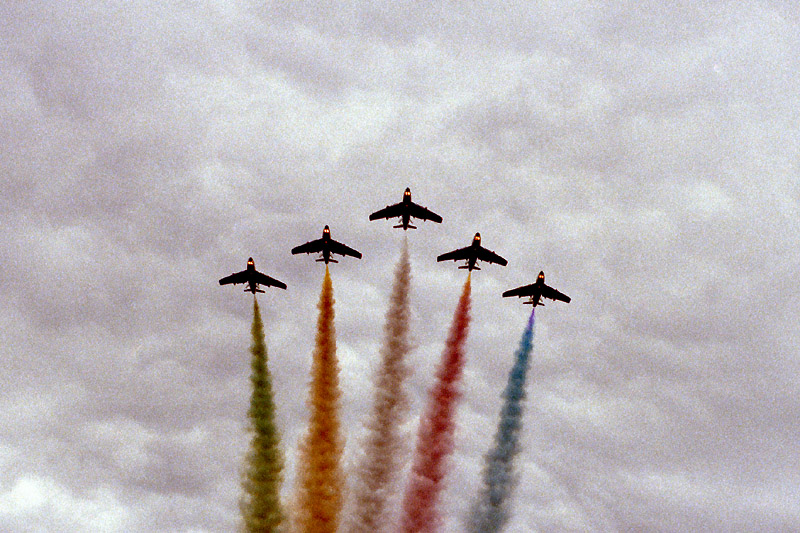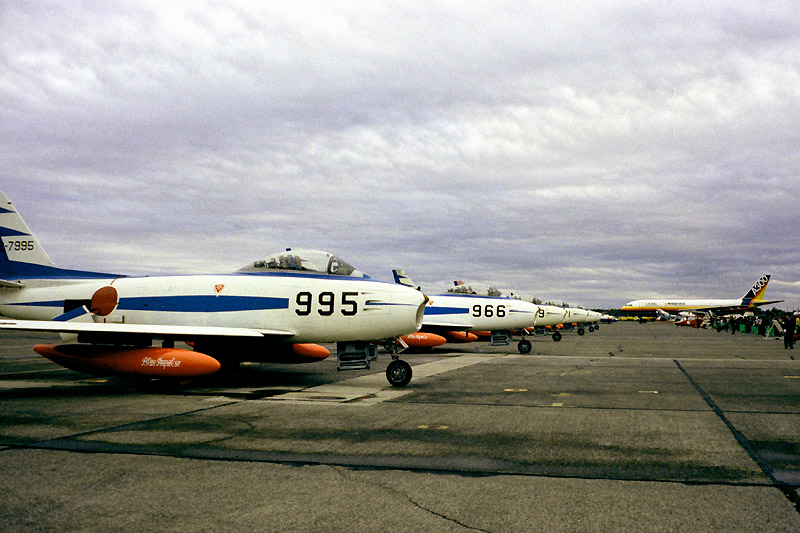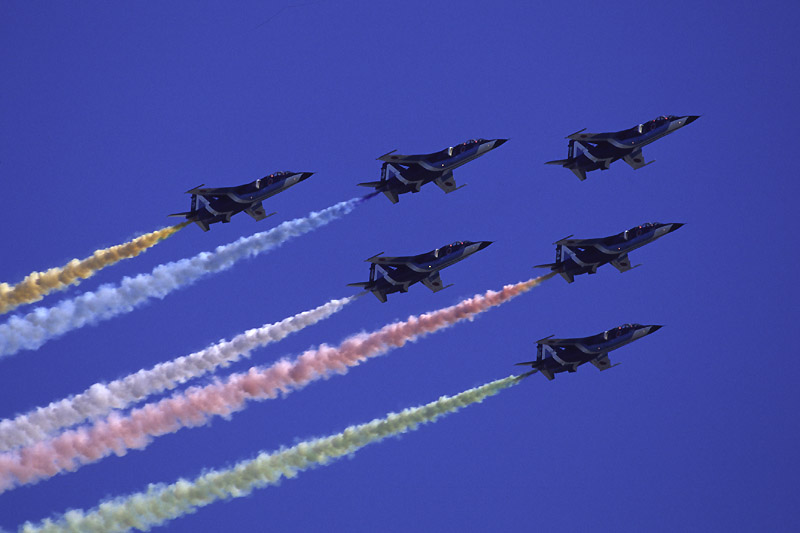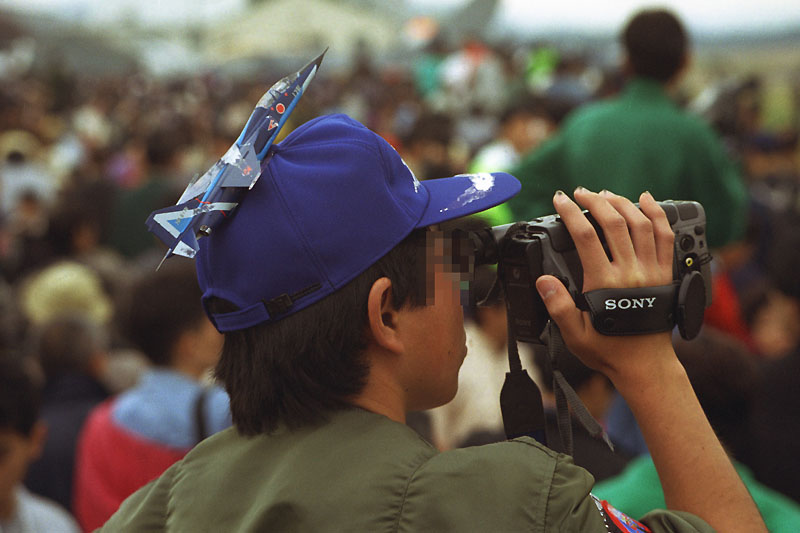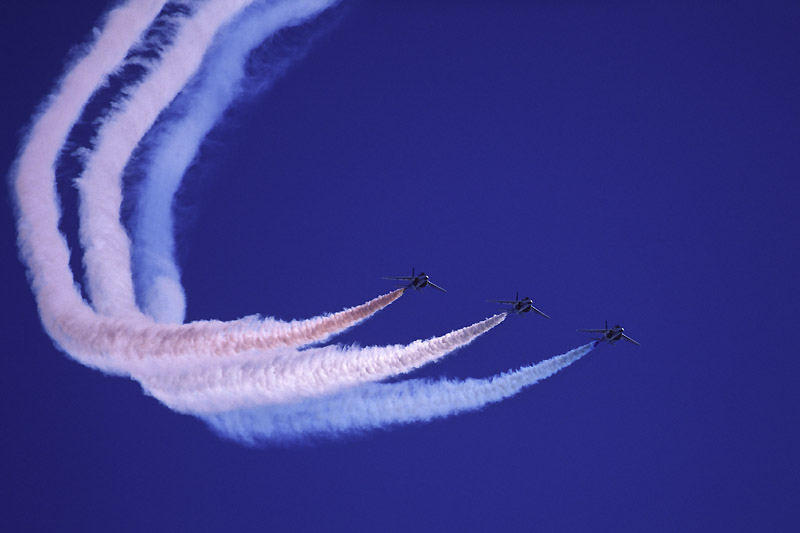|
F-86 Blue Impulse (1958 - 1981)
If you want to discriminate between American and European style acrobatic demo flight team, and if the criteria for American is a small number of fighter aircraft, then this is the only time Blue Impulse has been a true American style team.
I was a high school student when I first saw the Blue Impulse with F-86F fighter.
Yes, in the early '80s, JASDF was still using F-86F. By that time, although not as a fighter role, they were used as ground attack and recon.
It was a pity that my focus on aviation at that time was to the warbirds, so I did not pay much interest in them, but they were cool, flying low altitude and closer to me than any other demo teams I would see later on.
I remember seeing them 3 times at airshows. But the only time I took pictures was at the aviation expo held in Iruma air base.
I did not own a camera, so I borrowed from my father and took several pictures of them.
|
|
|
|
Five F-86Fs fly over me as they trail their traditional 5 color smoke.
It was not a perfect sunny day, so I remember they flew a low show.
Because the regulations and restrictions were much loose than today, I remeber seeing an aluminum with orange painted belly up close. They were flying very low altitude, very close to me - something we all miss in recent airshows.
Blue Impulse became famous for drawing a 5 color ring over the Tokyo olympics stadium, and also drawing the EXPO letter at Osaka.
They normally flew 4 formation + 1 solo = 5 aircraft flight, except in their home base Hamamatsu where they flew 6 aircraft with the dual solo.
|
|
|
|
Six F-86F (5 for display, 1 as reserve) line up on the apron of Iruma air base.
Blue Impulse started their formation flight using aluminum finish aircraft.
In 1964, a movie was shot starring Yujiro Ishihara as a pilot, and JASDF helped by providing the Blue Impulse for aerial shot, flying their aluminum finish.
After the movie was shot, the movie company Toho provided the white and blue paint scheme design to JASDF to appreciate for their cooporation.
The F-86F Blue Impulse always carried the drop tank during their performance.
Seen in the background is the Airbus A300 which the Japanese domestic airliner TDA had just made a contract to purchase.
TDA used to fly the white, red and green design aircraft, but since they adopted the A300, they changed all their fleet to White, Yellow, Red and navy blue design, which is the same as Airbus' old demo color.
Later on the airliner changed its name to JAS, and recently merged with JAL.
|
|
T-2 Blue Impulse i1982 - 1995j
I never liked this team.
When the T-2 Blue Impulse made its debut, it was one of the few teams in the world that used supersonic aircraft.
But the spec does not mean anything. You do not need supersonic during the show, anyway.
The show was boring, music they flew with was lousy, the paint scheme sucks.
It was in 1982, the same year they made their debut, on a sunny sunday in Hamamatsu air base, that they were performing their high show. The show proceeded as scheduled, and reaching their climax performance, "vertical downward break". After passing the top of the loop, the formation headed nose-down. When the formation leader called "Break", it was about 1 second late than supposed to be. Aircrafts had already passed the vertical dive status, in fact it was starting to pull up. After the "Break" call, number 4 aircraft, piloted by Takashima, had to make a 180 deg roll before pulling up from the dive, because he was supposed to break opposite to the formation leader. It was too low for the number 4 to recover. T-2 Blue impulse number 4 crashed into the used car shop in Hamamatsu city, injuring the civilian on ground and killing the pilot, who did not bail out.
T-2 Blue Impulse resumed their flight display in 1984, but the vertical downward break was never performed since the accident.
In 1991, another accident occured. While training over the ocean off Matsushima airbase, formation leader went into a vertigo due to a fog and 2 aircraft touched the ocean, killing the pilots.
Although they resumed performance in 1992, because of these accidents, T-2 Blue Impulse's performance became less and less attractive with more and more altitude because the priority now seems to be safety only.
But the real problem was extremely long interval between each performance.
Once a formation passes in front of you , you have to wait very long (easily 5 minutes) before the next formation arrives, even if it was a solo demo after the diamond.
As a taxpayer, I'm never ever happy with their performance.
|
|
|
|
T-2 Blue impulse formation take off from Hyakuri air base at dawn.
A flame is generated by burning the smoke oil with the afterburner heat. It is like a matchlight, it looks so cheap...
Note the No.7 is a reserve aircraft.
Unlike the F-86 Blue Impulse paint scheme, which was designed by professional, the T-2 Blue Impulse color scheme is by public application.
It has been designed by a group of high school girls.
I don't blame them, but couldn't the JASDF pick a better design...?
|
|
|
|
Flying high above you is the T-2 Blue Impulse Delta formation.
Yeah, they are really high and far away from you.
By the way, smoke in five colours are not bad.
|
|
|
|
Although I never liked T-2 Blue Impulse, there were some fans who liked them so much, that they even want to have T-2 always flying right above your head.
The model seems to be Hasegawa 1/72. As seen on this model, initially Blue Impulse did not have their aircraft number on its rudder.
|
|
T-4 Blue Impulse i1996 - todayj
Although the official start of this team was in 1996, T-4 Blue Impulse have been exposed to the public in the year before, i.e. 1995, during their home base Matsushima air base, Hyakuri JASDF training display and T-2 Blue Impulse last flight.
They were not official display, but an introduction to the up-coming new demonstration team to replace T-2 Blue Impulse.
When you look at T-2 and T-4 on the same day, it is very obvious that the T-4 is flying much low, with better performance, shorter interval and tighter formation.
I was really looking forward for the T-4 Blue Impulse to make their official debut.
Formal organization for T-4 Blue Impulse is 11th Hikotai (Sqn) of 4th Kokudan (Wing), JASDF.
It is the first time for JASDF to operate a squadron designated soley to acrobatic flight display mission.
In 1997, the T-4 Blue Impulse flew at the USAF 50th anniversary airshow in Nellis AFB, USA..
In 2000, flew for the Nagano winter olympic games opening, drawing 5 olympic color lines (not circles, because of the mountain surrounded terran) over the stadium.
In July 2000, an accident occured, losing 2 aircraft and 3 crew. The flight was suspended for the rest of the year.
Then later, some civilians complained that the die used for color smoke fell to the ground and contaminated some cars, and so it was switched to white smoke only. Too bad...
|
|
|
|
No, it is not French flag - neither is Dutch.
3 aircraft formation is never seen with T-2 nor F-86 Blue Impulse.
|
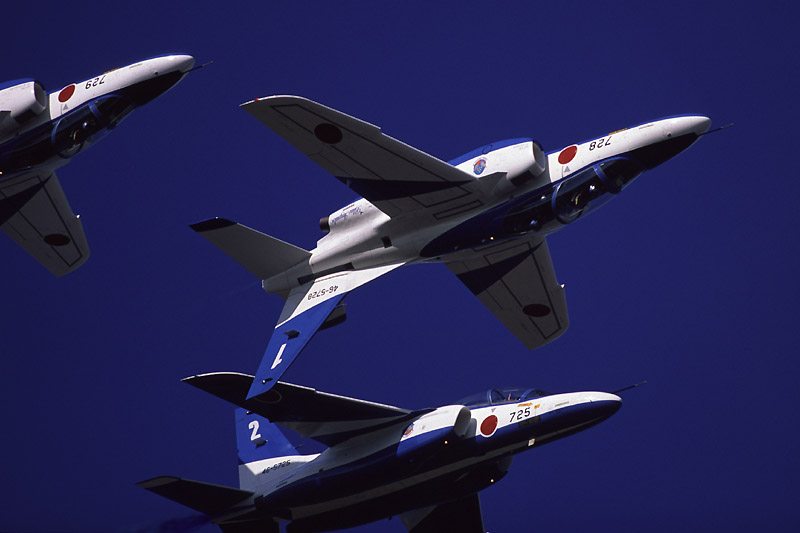 |
|
Close up of the Double-Farvel formation. (No.4 is out of frame)
Nice paint scheme!
|
|
|
"Rolling Combat Pitch" is the final maneuver for 4 aircraft, followed by leading and opposing solo's "Corkscrew"
|
|
|
|
And now the colored smoke can no longer be seen. Only the white smoke is used. |
Copyright 2005 Morimoto, Makoto : All Rights Reserved.
